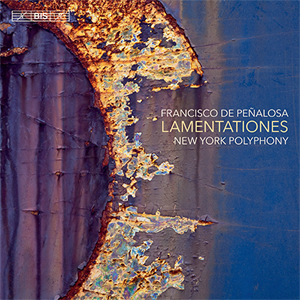Looking into the not-too-distant past—the early 1990s—you may recall another vocal quartet, not four men but four women, who called themselves Anonymous 4, and whose illustrious career spanned a couple of decades-plus. Their specialty was medieval chant and polyphony (with occasional forays into modern repertoire), and with each new recording—21 all together—the challenge for a critic to find something new and insightful to say about the performances (not to mention the sound quality) became increasingly difficult, and then impossible, because they all were just so…perfect. And here, in 2019, the male quartet New York Polyphony, already in its 13th year, commands similar respect and in its performances induces equally befuddled attempts by a commentator to find novel descriptions of what already amounts to, you guessed it, vocal ensemble perfection.
You might at first wonder at the choice of Peñalosa, described in multiple sources as an “important” Spanish composer (c. 1470-1528), but whose significance, based on appearances on today’s recordings and concert programs, would suggest a more modest status. On listening, however, you will not only (enthusiastically) switch the dial back from “modest” to “important”, but you will very soon understand this ensemble’s choice of repertoire: its particular style and voicing eminently suited to the group’s configuration—countertenor, tenor, baritone, bass—and the textures, rich with melody and harmonies that invite the rich resonance and vibrant, ringing vocal quality that mark New York Polyphony’s signature sound.
Although two sets of Lamentations get top billing here—impressive both musically, for effective text-settings and varied use of voicing, and in length (both more than 11 minutes)—I found the three movements from the Missa L’homme armé to be most affecting, displaying Peñalosa’s most clever vocal writing technique in the Gloria and affinity for sheer loveliness in the Agnus Dei.
And speaking of sheer loveliness, I have to say again how extraordinarily gorgeous is the sound of these voices, and how they perfectly move together through phrases while maintaining an absolute awareness of each line and its relative importance, its need to swell or diminish, to blend or assume prominence. Perfect ensemble singing, ideally recorded (at Princeton, New Jersey’s Princeton Abbey).
There are a couple more (shorter) Peñalosa pieces on the program—the gentle motet Unica est columba mea is a highlight—and the disc is rounded out with fine works by his contemporary Pedro de Escobar and successor Francisco Guerrero. The liner notes provide just enough interesting detail about Peñalosa and his music to make you want to find out more—not a bad thing. And the same could be said for this excellent recording.
































